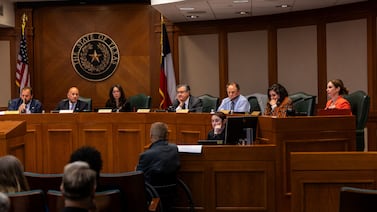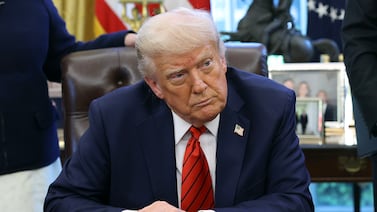Votebeat is a nonprofit news organization reporting on voting access and election administration across the U.S. Sign up for our free newsletters here.
I’m staring at a bubbly cursive signature on a screen with a loop in the letter T. It looks the same as the T’s in other signatures on the screen. I click “approve.”
I scrutinized letters like this over and over again as I sat at Maricopa County’s elections headquarters in downtown Phoenix last month. It was easier than I thought to spot consistencies – and inconsistencies – in the signatures on the screen in front of me.
A last name that trailed off in a distinct manner? Approve. Letters that changed from one signature to the next? Mark for further review.
I got going pretty quickly at times – approving a signature every three seconds or so – but then I would slow down as the voice inside my head reminded me that this was a crucial task. I was identifying potential forgery on ballots – and I was unqualified to do it.
This is how Arizona, and most states, check the identity of those casting mail ballots – by comparing the “voter affidavit signature” on the outside of the ballot envelope with a past example or examples of the voter’s signature in the county’s records.
I was looking at real signatures on real ballots, but this was only a test run to better understand the system. The county is allowing the media to come try their hand at verifying signatures because I’m not the only one with questions.
As GOP candidates and leaders have called into question the security of nearly every facet of Arizona’s election system in recent years, the signature verification process has been particularly scrutinized. GOP gubernatorial candidate Kari Lake has claimed fraudulent signatures were part of what caused her to lose by more than 17,000 votes to Gov. Katie Hobbs, though courts have so far decided she does not have evidence to prove this claim.
And as the 2024 election cycle begins, the challenges to this system that took root in 2022 are growing, not dissipating.
There are two ongoing lawsuits from Lake: Her latest appeal of her gubernatorial loss, and another case in which she is asking a judge to declare that voter signatures from the midterm election are public records.
But the challenge that is arguably the most consequential for 2024 and beyond is a case filed by the Arizona Republican Party and other conservative groups in Yavapai County Superior Court, which challenges what voter records county recorders can use to compare signatures. The case could lead to more rejected signatures in the future.
Secretary of State Adrian Fontes is watching that case as he attempts to finalize a new version of the giant rulebook that dictates the details of how election officials in the state run elections, the Elections Procedures Manual. He noted in his latest version sent to the governor earlier this month that there’s a pending case on the matter.
The lawsuits raise a question about whether signature verification is the best way to verify an early voter’s identity – a question that election experts and those of varying political leanings have been asking for years because it’s an imprecise and subjective process. Voting rights activists worry a mismatched or missing signature could lead to voter disenfranchisement, while GOP candidates and election officials claim it allows for fraud.
The debate is particularly important in Arizona, where voters can request an early ballot in the mail with no excuse needed and the vast majority of voters use this method to vote, instead of voting in person.
How Arizona verifies early ballots has national implications, too, because this process is the reason why the state’s presidential results are delayed. In November 2022, Maricopa County received around 290,000 early ballots on Election Day, and it took workers days to review the signatures on them so the ballots could be counted.
With all eyes on this process, I wanted to see firsthand how it works.
Three seconds for a signature
Lake’s main complaint against Maricopa County’s system is that workers move too fast to identify fraudulent signatures. Her team’s analysis found that some midterm election workers were approving a signature every second or two.
Her team was looking at the first-level review the signatures go through. These workers, typically temporary staff hired just for this purpose, have three samples to compare the ballot signature to. Of the signatures this worker approves, a portion will ultimately be audited. If the worker marks the signature for further review, known as an “exception,” the signature goes on to a manager with more training and all of the voter’s signatures on file to compare to. That manager makes the final call on whether the county needs to reach out to the voter to try to get confirmation from them that it was their ballot. If the county can’t reach the voter, the ballot is rejected.
I was acting as a Level 1 worker for my demo. I didn’t go through the eight-hour training these workers receive, but was briefed on what it entails. In particular, they are told that they aren’t looking for the signatures to match – but to be consistent. For example, is it cursive or print; was it written fast or slow; is it slanted; is it the full or partial name; and what do some of the signature features look like, such as the loop on an L.
In guidance to local officials, a federal election security council noted that this type of review should take less than 30 seconds per signature.
I was surprised during my demo to find that, most of the time, just a glance at the signature – focused on the style of writing and certain letters alone – was enough for me to approve it. There’s only so many ways you can write an N, but seeing the way that one voter made a large curve at the top of the letter the same way each time, I was confident it was the same voter signing the ballot.
Until I wasn’t.
“I want to tell John to get more consistent,” I said out loud at one point, repeatedly scrolling through the three signature samples I had for a voter named John before sending that ballot for further review.
Reaching the right voter
County officials assured me that by the time any ballot got to a mailbox, the county had already checked repeatedly to make sure it was going to the right place and would reach the voter – first by sending out a voter registration card when someone new registers to vote, and secondly by sending a mailer to the voter 90 days prior to the election to make sure they are still living at the address they provided.
If these mailings come back as undeliverable, the county tries to contact the voter to let them know, using any new forwarding addresses provided. This voter only stays in active status — meaning they are sent an early ballot — if they confirm their correct address with the county.
The state also regularly cleans its voter rolls using databases that notify them if someone moves or dies, and participates in the cross-state voter database called the Electronic Registration Information Center, which should notify counties if a voter registers in another state.
Maricopa County Recorder Stephen Richer, a Republican, argues with the key premise underlying claims of widespread signature fraud in the county’s elections. He told me there’s never been an indication that someone is stealing ballots en masse out of the mail.
“If we started getting reports of entire neighborhoods missing ballots, we’d investigate,” he said. “If we started getting reports of USPS trucks being attacked, we’d investigate. There’s no reason to believe any of that has ever happened.”
Multiple signatures for matching
I asked the county staff who I sat with during my demo to pull up my signatures from past elections and was surprised to see how much my signature has changed over time, losing a letter or two in my last name along the way and generally being written with more haste.
But all the signatures taken together, especially with the way I’ve always written the F in my last name, would probably signal to a worker it was me.
As I simulated the process, I was glad to have multiple other signatures from each voter for comparison. “That would make me nervous if there was only one to go on,” I told the county officials who were sitting with me.
But the pending case in Yavapai County could make for fewer comparisons statewide, if the case reaches the Arizona Supreme Court.
In Yavapai, the state GOP is arguing that state law doesn’t allow for recorders to look at voter signatures from past elections – just from when a voter registers to vote or updates their registration. While the case is pending, the Yavapai County judge has indicated in an early ruling that he agrees.
This would limit the number of samples recorders could consult, and therefore could lead to more signatures being questioned.
I reached out to the Arizona Republican Party about this, and heard back from Gina Swoboda, the party’s third vice chair who also served as an elections consultant for Republicans in the Legislature last year. She reiterated the party’s belief that state law doesn’t allow voter signatures from past elections to be used. While counties are relying heavily on a line in the Elections Procedures Manual that allows them to use more records, Swoboda said that line conflicts with state law.
“If the county recorders felt that they needed a change to perform their duties more effectively, the proper course of action would be to seek statutory changes through the legislative branch,” she said.
The party is hopeful that a final ruling in their favor from the Yavapai County judge will encourage recorders to work with the legislature to improve the process, Swoboda said.
The potential change in process to come from this lawsuit worries Jenny Guzman, the program director for Common Cause Arizona, which advocates for voter rights. The organization isn’t sure signature verification is the best way to verify a ballot, but wants to make sure that officials have a large database to work from if this is the method they are using, she told me. Officials should also be attempting to contact voters whose signature is being questioned, Guzman said, which happens in Arizona under state law but doesn’t happen in every state.
“Signatures should be allowed to change,” she told me. “It shouldn’t cause your ballot to be rejected.”
Is there a better way?
I left the demo both feeling more assured about the security of mail voting, but also wondering if there might be a better way.
Instead of using signatures to verify identity, some states ask voters to provide proof of identification with their mail ballot, such as a driver’s license number. Others require witnesses or notaries. But voting rights groups believe these methods create illegal barriers to voting, and they’ve sued states to try to stop them.
Arizona Republican lawmakers have attempted but so far failed to enact new laws that would use identification numbers instead of signatures to verify mail voters’ identities, in an attempt to move to a more objective process.
Guzman said Common Cause Arizona prefers signature verification over these other methods.
Richer told me even he isn’t sure that the county is using the best system. “I hate human involvement,” he said. “I wish we could computerize it. I hate there is inherent subjectivity.”
Guzman said her organization wants to leave AI out of it, though. Signatures shouldn’t have to match perfectly to be accepted, she said, and computers would be more rigid than humans in making these determinations, she said.
In Georgia, Secretary of State Brad Raffensperger wanted to make for a more objective, less subjective system, according to spokesperson Mike Hassinger. So, in 2021, the state enacted a new law that requires voters to provide their driver’s license number or other personal identification number. While signatures are still required on ballots, the state uses the ID number to verify identity, not the signature.
The method is “not only much less subject to subjective human interpretation, but also quicker for election workers, more easily understood by the voters, and easier to catch and correct errors if they occur,” Hassinger wrote in an email.
But a 2021 analysis by MIT Election Data and Science Lab found that states that require ID generally reject more ballots.
And that appears to have come true in Georgia. In 2020, about 0.05% of absentee ballots were rejected for mismatched signatures. When the county switched to verifying voters through ID numbers, in 2022, up to 0.58% of absentee ballots were rejected for this reason — although it’s unclear exactly how many, because it is included in an “other” category that may include other reasons for rejection.
But Hassinger said those two rates aren’t exactly comparable because the 2020 and 2022 elections and circumstances for absentee ballots were so different.
Guzman said Common Cause Arizona believes something is needed to verify mail-in voters’ identities, “but additional barriers is not the answer.”
Jen Fifield is a reporter for Votebeat based in Arizona. Contact Jen at jfifield@votebeat.org.






